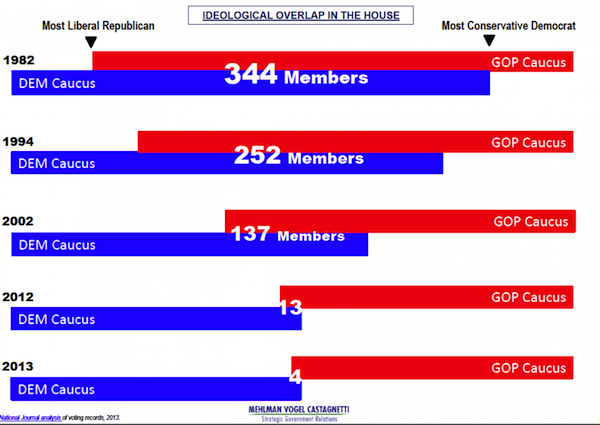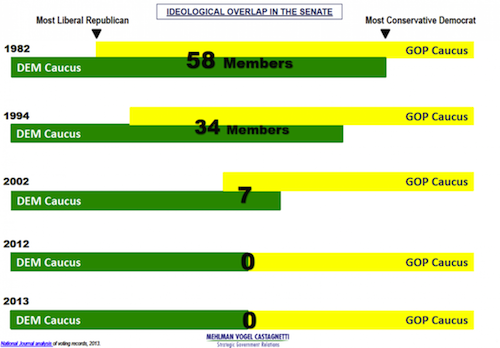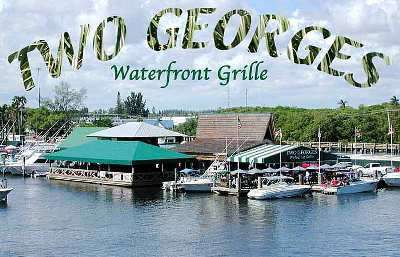In the Age of Trump, Republicans Are In for a Reckoning—Or a Realignment
Breaking and remaking the party system
Sitting in the ashes of Super Tuesday, what do Republicans see? Donald Trump, the reality-show Le Pen, carried seven states. Marco Rubio, darling of the party establishment, won just one. Several conservatives have started threatening to bolt to a third party if Trump gets the nomination; Trump keeps reminding everybody that he might run as an independent himself if the GOP denies him the crown. With the apocalyptic tone that now comes naturally to political reporters, some pundits are predicting not just a three-way race in November but the collapse of the Republican Party. (At last: an outcome I can root for!)
If you're trying to make sense of this chaos, here are two key facts to keep in mind:
1. Over the last half century, America's major parties have undergone a great sorting. There used to be a substantial number of liberal Republicans and conservative Democrats; now the GOP is fundamentally conservative and the Democracy is fundamentally liberal.
2. The meaning of "fundamentally conservative" and "fundamentally liberal" is extremely unstable.
The result of those two truths is a big mirage. What looks at first glance like a country polarized on opposite sides of a one-dimensional ideological spectrum turns out to be far weirder and more interesting than that. Our political system channels disagreements into two-way contests, but there are in fact far more than two tribes out there. Every now and then one of those hidden clans will erupt into view, disrupting business as usual and, if the explosion is big enough, reshaping the landscape. That's what seems to be happening now.
Before we get to the latest explosion, let's look at the sorting. Every year The National Journal rates the most liberal and most conservative members of Congress, based on how they voted on a selection of that session's bills. You can quibble with some of the Journal's choices, but at the very least they reflect Washington's conventional wisdom about how the left and the right behave. This chart, based on those ratings, shows the changing ideological makeup of the House of Representatives from 1982 to 2013:

As you can see, the number of conservative-voting Democrats and liberal-voting Republicans has steadily shrunk. The same thing has happened in the Senate:

Go back before the 1980s and you'll find even more diversity within the parties. In the '60s, one of the country's most prominent Republicans was New York Mayor John Lindsay, a man well to the left of most modern Democrats. One of the most prominent Democrats was George Wallace, the snarling face of opposition to the civil rights revolution.
Given all the chatter about a Republican split, I should note that both Lindsay and Wallace temporarily found refuge in third parties. When the GOP failed to renominate Lindsay in 1969, he nonetheless managed to get reelected mayor on the Liberal Party's line, winning in a three-way contest. Wallace, for his part, ran for president in 1968 as the candidate of the American Independent Party, carrying five states.
By 1972, Lindsay would be a Democrat and many Wallaceites would be Republicans, but Wallace himself would reenter the Democratic Party. Both Lindsay and Wallace ran in the Dems' presidential primaries that year; Lindsay performed poorly, but Wallace racked up 23.48 percent of the popular vote—barely less than the 25.34 percent earned by the eventual nominee, George McGovern. Aficionados of the "Donald Trump and Bernie Sanders have a lot in common" genre of campaign coverage may enjoy the spate of articles that appeared that year about "the two Georges," Wallace and McGovern, each appealing to the disaffected in different ways. In May of '72, for example, James Kilpatrick wrote this in a dispatch from Michigan, shortly before Wallace won the primary there:
What continues to amaze the correspondents, covering the Odd Couple, is the apparent inability or unwillingness of the voters to distinguish between the two. Every correspondent tells the same story: One falls into conversation with a barber, a cab driver, a waiter, a factory worker:
"Who are you going to vote for?"
"Wallace, I think."
"Yeah?"
"Or maybe McGovern. I dunno. One or the other."

The most alien thing about this, looking back from 2016, is that both Georges were running in the same party. Contrast that with Trump and Sanders, who naturally gravitated to the Republicans and the Democrats, respectively, even though both men are essentially independents. That's the great sorting in action. (After McGovern clinched the nomination, he asked Wallace for his endorsement. Wallace replied, "Senator, if I endorsed you I'd lose about half of my following and you'd lose half of yours.")
So the liberals gathered in the Democratic Party and the conservatives joined the Republicans. But what does that mean in practice? Most people don't fit those two categories as well as their elected representatives do, and the very definition of "liberal" and "conservative" tends to shift over time.
Consider the most clearly sorted partisan issue: abortion. While pro-life Democrats and pro-choice Republicans are sometimes viable on the state or local level, it is now effectively impossible to get the Democratic presidential or vice-presidential nomination without endorsing abortion rights or to get on the Republicans' national ticket without doing the opposite. Yet as the historian Daniel Williams' new book Defenders of the Unborn: The Pro-Life Movement Before Roe v. Wade reminds us, there was a time when leading members of the anti-abortion movement did not merely consider themselves liberals but saw their movement as a liberal one—in Williams' summary of their views, "an effort to extend state protection to the rights of a defenseless minority." The last pro-lifer to get on a national Democratic ticket wasn't some Blue Dog conservative; it was McGovern's running mate, Sargent Shriver.

Pro-life liberals and pro-choice conservatives aren't the only tribes excluded from the red/blue map. Libertarians have a tough time functioning in either party too. That's one reason Rand Paul ran such an unsatisfying, neither-fish-nor-fowl campaign this year, keeping one foot in The Intercept and the other in The Sean Hannity Show. Nor is there a welcoming home for someone like the George Wallace of the late '60s and early '70s, with his mix of racial resentment and economic populism. Wallace was able to remain a Democrat in good standing by becoming more liberal on civil rights. But not all his former followers did the same.
Hence the current chaos in the Republican ranks. Trump takes neither the racism nor the populism as far as Wallace did, but his campaign contains obvious echoes of what Wallace was doing four decades ago. And now voters who are disaffected with the Republican leadership, for reasons both healthy (opposition to foreign wars, resentment of the donor class) and not (racial paranoia, border-control fantasies), have a candidate with a serious shot at the GOP nomination. Pundits have a hard time describing Trump's politics, vacillating uncomfortably between calling him a moderate (Why, he's almost a liberal on entitlements!) and a dangerous extremist (Check out his crazy ideas about Mexicans and Muslims!). But that's what happens when you encounter someone whose views don't fit so neatly into your carefully sorted piles marked "left" and "right."
This also helps explain the paradox of the not-so-independent independents. The conventional wisdom in political science right now is that there are few "true" independents in the United States. Point out that 42 percent of Americans tell pollsters that they belong to neither major party, and the typical political scientist will respond that most of those self-identified independents still vote reliably for one specific party rather than switching back and forth. I suppose that may be a good retort to anyone convinced that 42 percent of Americans are swing voters, but does anybody actually think that? To me those poll results suggest a pent-up demand for political visions that aren't well represented by the parties' duopoly. If people who regularly vote for a particular party still prefer to identify themselves as independents, perhaps that's a sign they aren't satisfied with their choices. (One recent paper, produced by the Emory political scientists Alan Abramowitz and Steven Webster, suggests that such voters may be driven less by loyalty to the party they keep backing than by fear of the rival party.)
The last time we saw significant simultaneous populist insurgencies in the Democratic and Republican primaries—the Jerry Brown and Pat Buchanan campaigns of 1992—both candidates left their respective parties not long afterward, Brown becoming an independent and Buchanan joining the Reform Party. But like Lindsay and Wallace before them, both soon came in from the cold, the two-party system's relentless gravity drawing them back despite their dissatisfaction.
Maybe the GOP will see a bigger exodus this year; maybe it won't. Either way, there's going to be a reckoning over just what it means to be a Republican, and perhaps even a realignment—a new sorting. Just how such a sort would play out is anyone's guess. Beneath that two-colored map, a multihued mess of tribes is up for grabs.


Show Comments (164)